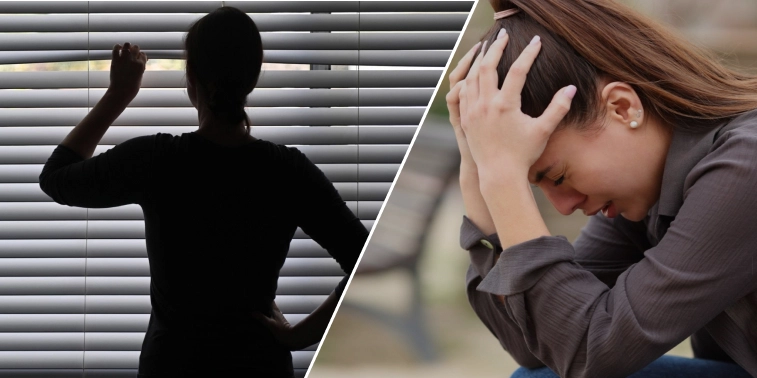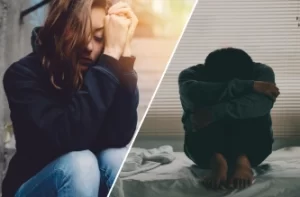Agoraphobia: Understanding and Overcoming the Fear of Open Spaces

Agoraphobia is a fear-based mental disorder that affects millions of people around the world. It is often described as an intense fear or anxiety surrounding situations where escape may be difficult, or help may not be readily available. While it can manifest in different forms, agoraphobia is most commonly associated with the fear of open or public spaces. With the increasing prevalence of this disorder, it is important to educate ourselves and understand how to overcome the fear of open spaces.
In this blog, we will explore the causes, symptoms, and treatment options for agoraphobia.
What is Agoraphobia?
Agoraphobia is a type of anxiety disorder characterized by an irrational fear of open or public spaces. It often leads to avoidance behaviors, where individuals limit their interactions with these spaces in order to avoid triggering their anxiety. This can range from avoiding crowded places like shopping malls or using public transportation to even leaving the comfort of one’s own home.
This mental disorder is classified as a specific phobia, which means it involves an intense fear or anxiety towards a particular object or situation. In the case of agoraphobia, the fear is directed towards situations where one may feel trapped, helpless, or embarrassed.
Furthermore, this disorder has different levels of severity, with some individuals experiencing mild symptoms while others may be completely debilitated by their fear. It is also worth noting that agoraphobia can occur alongside other mental health conditions, such as panic disorder, social anxiety disorder, or generalized anxiety disorder.
Agoraphobia and Panic Disorder
Agoraphobia is closely linked with panic disorder, a type of anxiety disorder where individuals experience recurrent and unexpected panic attacks. Panic attacks are intense episodes of fear or discomfort that can last for several minutes and are accompanied by physical symptoms such as heart palpitations, sweating, shaking, and shortness of breath.
The difference Between panic disorder and Agoraphobia is that while panic disorder is characterized by the fear of having a panic attack, agoraphobia revolves around the fear of being in situations where escape may be difficult, or help may not be available during a panic attack.
Panic Disorder Without Agoraphobia
While agoraphobia and panic disorder often coexist, it is possible to have panic disorder without having agoraphobia. In this case, individuals may experience panic attacks in a variety of settings and situations, including open or public spaces. It is not enough to only have a fear of open spaces for a diagnosis of agoraphobia, as the intense fear or avoidance must be specifically related to panic attacks.
Is Agoraphobia a Disability?
Agoraphobia can significantly impact an individual’s daily life and functioning. In severe cases, it may even lead to disability, making it difficult for individuals to leave their homes or participate in normal activities such as work or social events.
However, agoraphobia is not considered a permanent disability unless it severely limits an individual’s ability to function in different areas of their life. With proper treatment and support, many individuals with agoraphobia are able to manage their symptoms and lead fulfilling lives.
Symptoms of Agoraphobia
The symptoms of agoraphobia can vary from person to person and may change over time. Some common symptoms include:
- Fear or anxiety in open or public spaces
- Avoidance of certain situations, such as crowded places or using public transportation
- Panic attacks when exposed to feared situations
- Feeling trapped, helpless, or embarrassed in social settings
- Physical symptoms such as heart palpitations, sweating, trembling, or shortness of breath
- Difficulty leaving the house or being alone
- Social isolation and withdrawal from activities that were once enjoyed
If you are experiencing any of these symptoms, it is important to seek professional help for a proper diagnosis and treatment plan.
What causes Agoraphobia?
The exact causes of agoraphobia are still unknown, but research suggests that a combination of factors may contribute to its development. These include:
Genetic Predisposition: Studies have shown that there may be a genetic component to agoraphobia, meaning it can run in families. If you have a close family member with the disorder, you may be at higher risk of developing it yourself.
Traumatic Experiences: Agoraphobia can also be triggered by traumatic experiences, such as being in a situation where escape was difficult or help was not available. These experiences can lead to a fear response that gets associated with certain situations or places, leading to avoidance behaviors.
Underlying Anxiety Disorders: As mentioned earlier, agoraphobia is often linked with other anxiety disorders, such as panic disorder or social anxiety disorder. If you have a preexisting anxiety disorder, you may be more susceptible to developing agoraphobia.
Substance Abuse: Substance abuse and addiction have also been identified as potential risk factors for agoraphobia. While substance use does not directly cause the disorder, it can worsen symptoms and increase the likelihood of developing it.
Diagnosis of Agoraphobia
Diagnosing agoraphobia involves a thorough evaluation by a mental health professional. They will assess your symptoms, medical history, and any potential underlying causes to determine if you meet the criteria for the disorder. The diagnosis of agoraphobia is based on the diagnostic criteria outlined in the Diagnostic and Statistical Manual of Mental Disorders, fifth edition (DSM-5).
According to the DSM-5, a person must meet the following criteria to be diagnosed with agoraphobia. Fear or anxiety about two or more of the following situations:
- Using public transportation (such as buses, trains, or planes)
- Being in open spaces (such as parking lots, marketplaces, or bridges)
- Being in enclosed spaces (such as shops, theaters, or elevators)
- Standing in line or being in a crowd
- Being outside of the home alone
- The person fears and avoids these situations due to thoughts that escape might be difficult, or help might not be available in the event of developing panic-like symptoms or other incapacitating or embarrassing symptoms.
- The fear, anxiety, or avoidance is persistent and lasts for at least six months.
- The fear, anxiety, or avoidance is not better explained by the presence of another mental disorder.
Agoraphobia can also co-occur with other anxiety disorders, such as panic disorder and specific phobias. Therefore, it is essential for a mental health professional to conduct a comprehensive evaluation to differentiate between these disorders and determine the appropriate diagnosis.
The evaluation may also include physical exams and tests to rule out any medical conditions that could be causing symptoms similar to agoraphobia. It is crucial to rule out any underlying medical conditions, as these can also contribute to the development of agoraphobia.
Is agoraphobia Curable?
Agoraphobia is a type of anxiety disorder that causes individuals to experience a fear or avoidance of certain situations or places. This often includes open spaces, crowds, and unfamiliar environments. People with agoraphobia may feel trapped or embarrassed in these situations and may avoid them at all costs. While there is no definitive cure for agoraphobia, there are treatment options that can help individuals manage their symptoms and lead fulfilling lives.
Agoraphobia Treatment Options
The most common form of treatment for agoraphobia is psychotherapy, also known as talk therapy. This involves talking to a therapist about your fears and learning coping mechanisms and strategies to manage them.
Therapy
Cognitive-behavioral therapy (CBT) is the most commonly used form of therapy for treating agoraphobia. It focuses on identifying and changing negative thought patterns and behaviors that contribute to the fear and avoidance of certain situations. CBT can also help individuals develop relaxation techniques, such as deep breathing and muscle relaxation, to manage anxiety in triggering situations.
Medication
In some cases, medication may be prescribed to help manage symptoms of agoraphobia. Antidepressants and anti-anxiety medications are commonly used to treat this disorder. These medications can help regulate the levels of chemicals in the brain that contribute to anxiety and fear. However, it’s important to note that medication should not be solely relied upon and should be used in conjunction with therapy for best results.
Self-Help Strategies
In addition to therapy and medication, there are self-help strategies that individuals with agoraphobia can practice on their own. These include gradually exposing oneself to triggering situations and practicing relaxation techniques, such as meditation or yoga. It’s also important for individuals to maintain a healthy lifestyle by getting enough sleep, exercising regularly, and eating a balanced diet.
How to Overcome Agoraphobia Fast?
There is no quick fix for agoraphobia, as each individual’s journey to recovery may vary. However, it is possible to overcome agoraphobia with the right treatment and support.
Some ways to help speed up the process of overcoming agoraphobia include:
Seeking professional help: A mental health professional can provide the necessary support and guidance for managing agoraphobia. They can also tailor treatment plans to fit an individual’s specific needs and circumstances.
Practicing self-care: Taking care of oneself physically, mentally, and emotionally is crucial in managing anxiety disorders like agoraphobia. This includes getting enough rest, eating well, and engaging in activities that bring joy and relaxation.
Joining support groups: Connecting with others who have experienced or are currently struggling with agoraphobia can provide a sense of understanding and comfort. Support groups also offer a safe space to share experiences, challenges, and coping strategies.
Being patient and persistent: Overcoming agoraphobia takes time and effort. It’s important to be patient with oneself and celebrate even small victories. It’s also essential to continue practicing therapy techniques, self-help strategies, and medication (if prescribed) consistently.
Agoraphobia in Children
While agoraphobia is more commonly diagnosed in adults, it can also occur in children. Children with agoraphobia may experience excessive fear or anxiety about being separated from their parents or caregivers, as well as specific situations like school or social events. It’s important for parents and caregivers to recognize signs of agoraphobia in children, such as refusal to attend school or participate in activities, and seek professional help if needed. With early intervention and proper treatment, agoraphobia in children can be effectively managed.
Conclusion
Agoraphobia is a complex anxiety disorder that can greatly impact an individual’s daily life. It is not curable, but it is possible to manage symptoms and improve overall quality of life through therapy, medication, and self-help strategies. Seeking professional help and practicing patience, persistence, and self-care are essential in overcoming agoraphobia.
With the right support and treatment, individuals with agoraphobia can lead fulfilling lives without being hindered by their fears. So, if you or someone you know is struggling with agoraphobia, reach out for help and know that there is hope for recovery.



